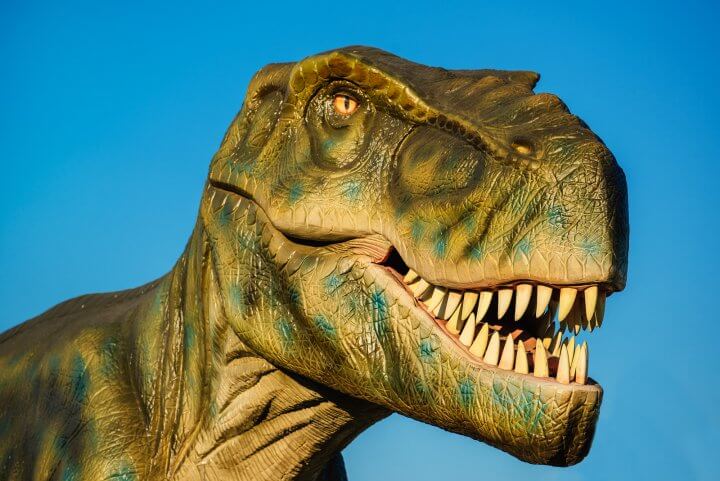
Arguably the most popular of all of the dinosaurs known to date, the Tyrannosaurus Rex, also coined the T. Rex, roamed the earth about 65 million years ago. Spending its existence near the top of the era’s food chain, the “Tyrant Lizard King” roamed Asia and North America. At the time of its discovery, the Tyrannosaurus Rex was believed to be the largest of carnivorous dinosaurs, however, later discoveries of the Carcharodontosaurus and the Giganotosaurus proved otherwise.
What did the T.Rex Look Like?
The typical Tyrannosaurus Rex towered over its dinosaur brethren. Often standing over 20 feet tall and weighing as much as 8 tons, the T. Rex’s head was the size of a small sedan. With two small, but powerful arms, the dinosaur ran upright much like an ostrich. These similarities combined with the evidence that Tyrannosaurus hatchlings were covered in feathers has fueled the belief that many dinosaur species were descendants of birds. The T. Rex’s length was impressive, as well, measuring 40 feet from head to tail.
What Made the Tyrannosaurus Such an Incredible Predator?
Incredible eyesight combined with a keen sense of smell gave the T. Rex all it needed in tracking and capturing its prey. Due to the height and proportionally long legs, the king of the dinosaurs was able to reach speeds of 25 miles per hour when at a full sprint.
In addition to the predator’s incredible physical capabilities, certain aspects of its hygiene are thought to have played a role it the hunting abilities. Because bacteria built up in the teeth of the T. Rex, many theorize that there was a “toxic” effect that the bite could have on prey. By simply breaking the skin of another dinosaur, the Tyrannosaurus could induce death through infection alone. As if it needed any help?
There are varying opinions regarding the hunting patterns of the T. Rex. Many believe that they were solitary hunters that lingered on the fringe of forested areas preying on Triceratops and other herbivores that grazed in the area.
The Fossil Discovery
Tyrannosaurus Sue, the largest fossil of a T. Rex ever discovered, is named after her founder, Sue Hendrickson. While on an expedition in South Dakota, Hendrickson discovered the 85% complete fossilized remains of the massive dinosaur. Unfortunately, shortly thereafter, legal battles led to an auction of the fossil, with the winning bidder, Chicago’s Field Museum of Natural History spending $8 million to acquire and showcase the impressive find.
T. Rex: the Movie Star
It’s no wonder that the Tyrannosaurus Rex is the most popular of all the dinosaurs. Earning a reputation of ferocity and cunning hunting skills, Hollywood has glorified this keystone predator in many movies. Films such as Jurassic Park offer up life-like, live action scenes of this impressive beast, utilizing information gathered regarding movement, intelligence and overall capabilities. The insight gathered has led to increased interest in the “tyrant lizard king”, and when it comes to dinosaurs, there’s no doubt who has become the “fan favorite”.

Leave a Reply